REVISITING THE HISTORY OF THE FIRST CHROME POSTCARD
by Susan Lane, Aug 2011
So often when looking at a postcard, series or collection you want more information. With books. libraries,
the Internet and friends to turn to, there is plenty on the early history of postcards. Yet contemporary
information is not often available. Even when information can be retrieved details are lost, misused and
misquoted. With the advent of the internet, misinformation and errors have spread like wildfire, so it is
even more important for corrections based on new research be widely distributed.
For example, both the R. H. Macy's postcard set and the Union Oil Company's cards were produced as early
chromes in 1939. However, it is the Union Oil Company cards which are the ones referred to as the first in
the use of this technique. It is my guess that this came about because of the hundreds of cards and sets
produced by Union Oil, compared with the 16 cards produced by Macy's in their Color Views of New York.
Don Preziosi in his July 2006 article in Postcard Collector wrote about an earlier chrome card that he found,
a discovery that should not be ignored in the history of postcards and their production. This card was issued
and mailed in September 1936 as an advertising card for the new magazine The New York Woman. Don links this
halftone technique and the descriptive "chrome postcard" to the introduction by Kodak of its new Kodachrome
film for slides. To put a further spin on this story, the use of Kodachrome ended after a seventy five year
run. In December of 2010, the processing of Kodachrome film ended with the last processing machine shut down.
Perhaps someone has started taking notes on the history of the digital era.
LINENS AND BEYOND
THE FIRST CHROME POSTCARD
Revising Postcard History
by Don Preziosi
During the almost 30 years that I have been involved in the postcard hobby, the accepted wisdom has been that
the first chrome postcards were published by the Union Oil Company in 1939. (Shown here is Treasure Island at
the Golden Gate Expo, “No. 70 in UNION OIL COMPANY’S Natural Color Photographic Scenes of the West”). I have
never been able to find the origins of this claim, but it has been perpetuated in virtually every version of
postcard history or card types that I have ever seen.
One thing that always puzzled me was that the R.H. Macy Co. in New York also published a 16-card set,
copyrighted in 1939, called “The Macy Color Views of New York.” (Shown here is “The Gay White Way, N.Y. …
Broadway and Seventh Avenue meet in a blaze of light.”) Both sets of postcards are printed by the same four-color,
photomechanical, halftone process that identifies all chrome postcards. Neither of these sets has the shiny
varnished, lacquered, nor plastic coating that characterize most chrome postcards. The Macy’s cards however are
never mentioned in postcard histories as being the first chrome postcards.
Whether the Union Oil cards or the Macy’s cards were the first chrome postcards is now a moot point, because a
recent purchase at the Metro New York Postcard Show clearly proves that a chrome postcard was issued in September
of 1936 by a new magazine called “The New York Woman.” The front and back are shown here along with a 20-times
detail to show the photomechanical halftone dots. In addition, this card has the shiny lacquered surface so typical
of a chrome postcard.
What Makes a Chrome Postcard Different?
The defining feature of a chrome postcard is that the card has been reproduced from a color photograph by a
photomechanical color halftone process. Prior to chrome postcards, all of the color on postcards was added by hand
by one method or another. The original photographic images all started as black and white photos. In the simplest form,
the color was literally painted onto a printed image, usually by an assembly line of women. Albertype was one of the
publishers that mastered this form. In chromolithography and other processes, several or more color plates (or
lithographic stones in the case of true chromolithography) were created by hand to produce a color image, per the
instructions of the persons publishing the cards. (There were too many different postcard printing styles to go into
more detail about this here).
The Invention of the Halftone Process
A halftone is a method for reproducing gray shades by using only one color of ink. Prior to the invention of halftones
by American printer Frederic Eugene Ives in 1880, photographic images were reproduced in print by artists’ woodcuts or
line engravings. These methods only allowed for black lines on a white surface to create any tones. Since photographs are
continuous tone images, middle tones could not effectively be reproduced. Ives developed a system for reproducing shades
through the use of large and small dots.
In halftone reproduction, the original photograph is placed behind a screen-like grid of crossed lines and photographed
onto a light-sensitive metal plate (later on it was a film). The result is an image that is made up of lots of very tiny
dots of varying size. The halftone's varied dot sizes enabled the reproduction of shades ("half tones") in a printed picture.
Large dots placed closely together appear black. Smaller dots with larger spaces between them produce a gray shade. The
tiniest dots spaced widely apart create an almost white area. The finer the grid that was used, the more subtle the tones
that could be reproduced and the more the printed image will look like the original photograph.
Color Photography
The first color photographs (not hand-tinted!) were autochromes. This was a cumbersome glass-plate process using microscopic
grains of potato starch that was introduced in 1907. They were the major form of color photography before the invention of
color film in the 1930’s. Aside from the inconveniences in making autochromes, their colors were generally muted. Other
transitional color processes were developed, including the glass-plate based Paget color and Finlay color, and a film based
Dufay color. However, it was not until the introduction of Kodachrome film for slides in 1936 that color photography could
be used widely for the print medium (and for pleasure!). Kodachrome was smaller, portable, capable of faster exposures, and
the color was much more accurate. Most postcard histories suggest that the term “chrome” is derived from Kodachrome, although
some suggest “Photochrome” as the origin. This is not likely because the Photochrom (the original spelling) process was done
with lithographic stones.
Color Halftones
If you look closely at a color chrome postcard, you'll see that they're actually made up of tiny dots of four colors: cyan,
magenta, yellow and black. (The inset of the face of the New York Woman that is shown illustrates this) These colors are called
process colors (also referred to as CMYK -- the K stands for "key line"). They are used to reproduce full-color images on a
printing press. Each one of these colors requires a halftone plate. These plates are made like the black and white plates
mentioned above, except that through the use of color filters all but one of the process colors is filtered out.
Since our eyes cannot see individual halftone dots, the merging of the four different dot colors into “rosettes” creates the
illusion of a wide spectrum of color. To form a rosette, the four individual color halftone screens must be placed at different
angles. Otherwise, when the plates are printed to produce a final image, the dot patterns would completely overlap, creating a
muddy, unrecognizable image. The ultimate result of the photomechanical four-color halftone process varies from one type of
printing process to another, each with its own look.
Revising Postcard History
It was exciting for me to realize that this may very well be the first true chrome postcard issued in the United States. The
challenge now would be for a reader to come up with an earlier card that has been photomechanically reproduced from a color
image. Get out your magnifying glasses and look for those color rosette dot patterns. And please let me know if you find an
earlier card.
(Thanks to Dan Friedman for the 1939 Union Oil postcard and Virginia Faulkner for research assistance.)
|
click images to view larger
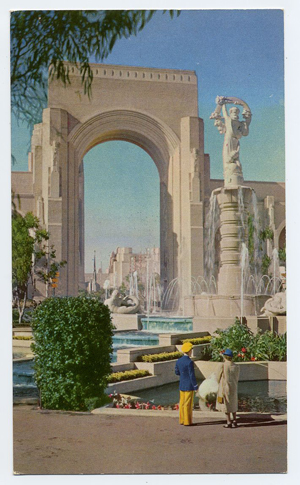

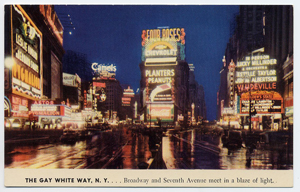

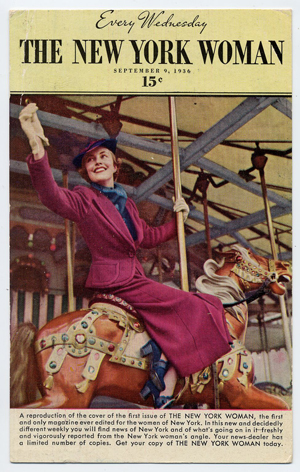
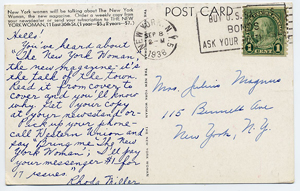
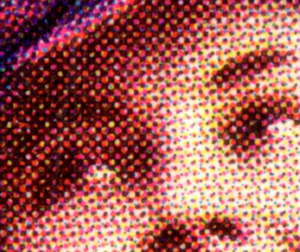
|










